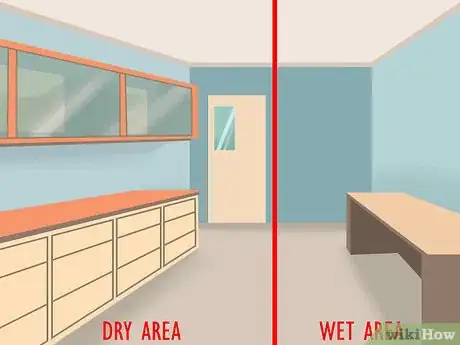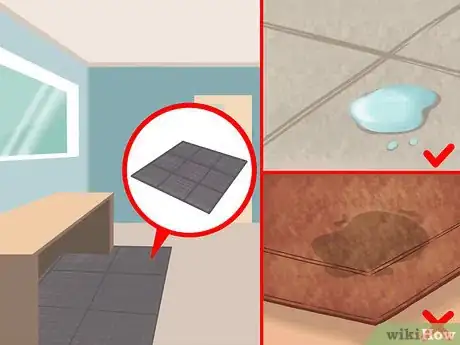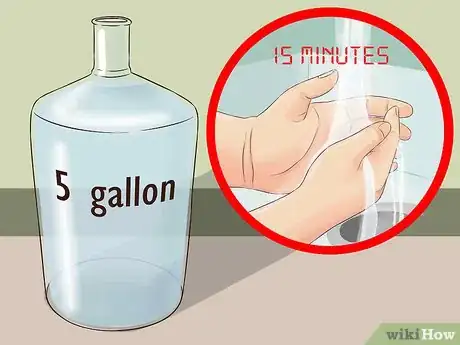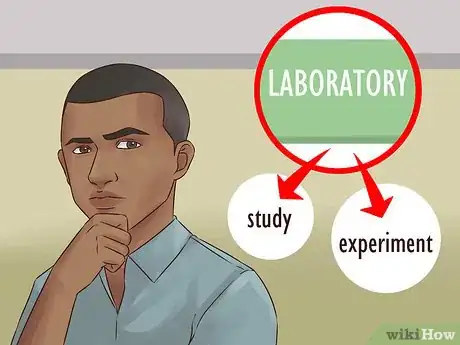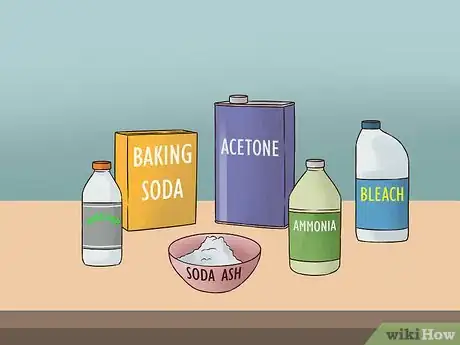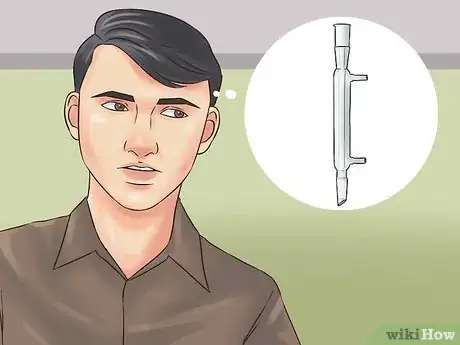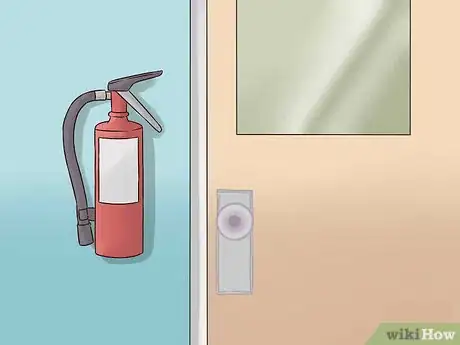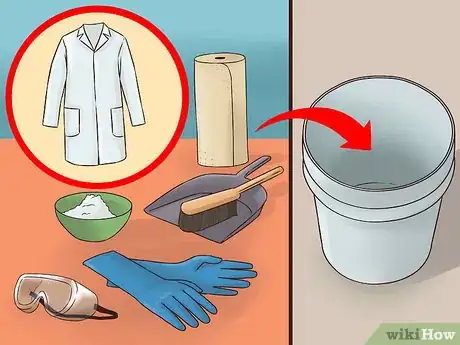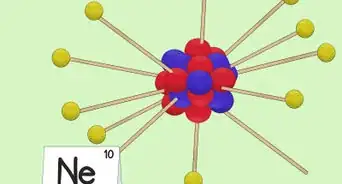This article was co-authored by Meredith Juncker, PhD. Meredith Juncker is a PhD candidate in Biochemistry and Molecular Biology at Louisiana State University Health Sciences Center. Her studies are focused on proteins and neurodegenerative diseases.
There are 8 references cited in this article, which can be found at the bottom of the page.
wikiHow marks an article as reader-approved once it receives enough positive feedback. In this case, 89% of readers who voted found the article helpful, earning it our reader-approved status.
This article has been viewed 64,661 times.
If you really enjoy doing chemistry experiments, it might be a good idea to build your own lab at home. It is essential that you do everything safely and obtain chemical supplies in an appropriate way. There are a lot of factors that go into choosing the correct space and deciding what instruments you will need. Once you have the basic lab set up, you can get more advanced and add things specific to your needs.
Steps
Choosing Your Location
-
1Select a space with access to electrical outlets. For best results, use a spare room that has electrical outlets. If you don’t have a spare room, try to remove any non-essential items from the space. If necessary, you can use a power strip to plug in the necessary equipment.
-
2Make sure there is plenty of counter space. You want to make sure you have plenty of space to set up and perform your experiments. A cluttered counter is difficult to work with and can lead to spills or damage to equipment. Ideally, you will have enough space to have a “wet” and “dry” side to work with. The “wet” side is for actual experiments, while the “dry” side is for supply storage.[1]
- You’ll also need plenty of space for the items you frequently use, such as glassware and chemicals.
- If you’re concerned about ruining a good counter, place a towel on top of the counter and then a rubber non-slip mat on top of that. This will protect the counter and absorb any spilled chemicals.
Advertisement -
3Choose an area that is well-ventilated and temperate. Many chemicals and chemical reactions release volatile fumes that can be hazardous to your health. Proper ventilation is essential for your home chemistry lab. In addition, you want to work in a dry and temperate space. Temperature is important for the long-term storage of many chemicals.[2]
- While basements are spacious, they are not an ideal environment because they are usually poorly-ventilated, cold and damp during the winter, and hot and humid during the summer.
- An open window and portable exhaust fan can serve to increase ventilation in any room.
- If possible, work outside for experiments that produce lots of smoke or fumes.
-
4Ensure the location has a lot of light. Being able to see what you are doing during experiments is extremely important. If your space does not have enough light, buy some floor lamps to increase the lighting. A well-lit space will help avoid injury while experimenting.[3]
- Rooms with windows provide nice natural light and increase the ventilation.
-
5Use a “spill-proof” floor. Avoid rooms that have a porous floor such as carpet or wood. Spilled chemicals will be absorbed and ruin those surfaces. Vinyl or linoleum floors work very well because they are easy to clean and won’t absorb chemicals. Concrete flooring works as well, but is porous and can absorb spills. Consider coating it with latex or epoxy.[4]
- You can also purchase rubber flooring mats to cover the area of your workspace.
-
6Work near running water. Although not essential, having access to running water and the sewer system can be very convenient. It is good not only for your experiments but also from a safety perspective. If this is not possible, fill a large container, such as a 5-gallon carboy, with water. You will need water for many of your experiments and it is useful to have a large amount nearby.
- If you get something in your eye or spill chemicals directly on you, rinse the affected area with water for at least 15 minutes before seeking further treatment.
Obtaining Lab Supplies
-
1Identify the purpose of your lab. First, you need to establish the type of work you’re going to do in your lab. For instance, a biology lab will be set up differently than a chemistry lab. Similarly, your needs are going to be different if you’re a student doing science fair experiments versus a more advanced scientist performing complex reactions at home.[5]
- As a beginning scientist, you can start out with a home scientist kit, a few beakers, and work with supplies that can be found around the house.
- If you are trying to do more complicated research, you will need accurate measuring devices, heating devices, and well-made glassware.
-
2Purchase essential supplies. Obtain a filtration system so you can filter your solutions in order to reduce the risk of contamination. Beakers, Erlenmeyer flasks (with stoppers), and graduated cylinders of various sizes will be invaluable to your experiments. Sizes ranging from 250 mL to 1000 mL are good to start with. Small plastic pipettes, test tubes, racks for test tubes, heat resistant tubing, and a funnel are also useful to have on hand.
- Burettes for titrations might also be useful for some chemistry experiments.
- As you use your lab more, you will get to know what you need more of and what you don’t need.
- High-quality student-grade equipment is usually sufficient for the work you would be doing at home and is much less expensive than professional-grade. Beware though, if it seems too cheap, it probably is.
-
3Get the basic equipment and tools for experiments. Thermometers, pH paper, a milligram scale, hot plates, stir plates, and stir bars are all essential to starting a lab. Tools such as forceps, scoops, and tongs for hot flasks are useful as well. A small basic microscope might also be beneficial.[6]
- Some of these supplies are not cheap, but consider them an investment. If you buy something cheap, you may not get the results you are looking for.
- Many of these basic supplies can be purchased easily online from sites like Thermo Fisher Scientific, Sigma Aldrich, or even Amazon.[7]
-
4Gather basic chemicals. Many chemicals for your lab can be easily purchased at grocery stores, hardware stores, lawn and garden stores, and pottery supply stores. Chemicals such as baking soda, soda ash, bleach, acetone, vinegar, and ammonia are all good basics to have on hand.[8]
- Some chemicals that can’t be purchased in stores can be synthesized from those that are easily purchased.
- Be aware of the strength of the chemicals that you are using. Read all product labels and material safety data sheets before use.
-
5Consider purchasing more advanced equipment. Identify the purpose of your lab. Knowing the types of experiments you want to do will help you determine the type of advanced equipment you may need. You may need glass condensers or better more expensive tools.
- Some of this equipment can get expensive, so make sure it will really be useful to you if you are going to purchase it.
-
6Keep a laboratory notebook. A good scientist keeps track of all of their work. Start a laboratory notebook and write down all of your experiments: the procedure you did, what you thought would happen, what actually happened, and what you will do with that information.[9]
- Date everything and keep your notebook current.
- You can also use your notebook to track the use of your chemicals and their expiration dates.
Being Safe
-
1Wear proper protective equipment. The most important aspect of lab safety is having the proper equipment to protect you while working. Always wear a lab coat to protect your clothes and skin from damage. Latex or nitrile gloves should be worn at all times when handling chemicals. Goggles that protect both your eyes and the sides of your eyes are also essential.
- Closed-toe shoes should always be worn while working.
- Long pants should also be worn to protect your legs.
- Tie your hair back in a ponytail or bun if it is long.
- Never eat or drink while experimenting.
-
2Store chemicals safely and label each one. Flammable and corrosive chemicals should be stored in a special cabinet to prevent fire or explosions. These chemicals should also be stored in separate containers within the cabinet to prevent them from reacting with each other. Never store chemicals near household items like food and drinks. Be sure to label each chemical and solution as well.[10]
- Include the name of the chemical or solution, the concentration of the solution, the pH, the date the solution was made, and any other pertinent information on each label.
- Read the material safety data sheets (MSDS) for all of the chemicals that you own to store them properly.[11]
- Use the proper storage container for your chemicals. Select airtight, chemical-resistant containers. Some strong acids can only be stored in plastic, while other chemicals may need to be stored in glass.
- Make sure hazardous chemicals are stored under lock and key or safely away from the access of small children or pets.
-
3Keep a fire extinguisher nearby. Always have a fire extinguisher nearby and a working smoke detector in the area. Make sure the fire extinguisher is not expired and keep it in an easily accessible location. Get a fire extinguisher that works against ABC or BC fires (can be corrosive to metals, but useful for chemical, electrical, and ordinary burning materials). These work best against chemical fires, but are not effective against strong alkali (basic) or strong acid fires.[12]
- Check the status of the fire extinguisher and the smoke detector once a month to make sure they are both in working order.
- Never throw water on a strong acid. It will explode.
-
4Make a spill kit. Spills are inevitable in the lab and having a spill kit will help you keep the spill from turning into something major. Keep your spill kit easily accessible and ensure all materials are within their expiration date. Make a spill kit that contains the following items:[13]
- Latex gloves
- Eye protection that covers the sides of your eyes
- Apron or lab coat
- Dustpan and brush (also useful for broken glass)
- Absorbent materials: kitty litter, sand or clay, and absorbent pads
- Neutralizing materials: baking soda for acid spills; citric acid for basic spills
- Store all items in a 5 US gal (19 L) polypropylene (plastic) bucket. Use the bucket to contain all the materials after cleaning up the spill.
Expert Q&A
-
QuestionHow should I use laboratory notebook?
 Meredith Juncker, PhDMeredith Juncker is a PhD candidate in Biochemistry and Molecular Biology at Louisiana State University Health Sciences Center. Her studies are focused on proteins and neurodegenerative diseases.
Meredith Juncker, PhDMeredith Juncker is a PhD candidate in Biochemistry and Molecular Biology at Louisiana State University Health Sciences Center. Her studies are focused on proteins and neurodegenerative diseases.
Scientific Researcher Lab notebooks are super important because they are a permanent record of what you did in lab. It can also be important for intellectual property (IP) in the future, should you want to patent something. To start, purchase a lab notebook of your liking. I personally use one that has gridlines on it, which makes it easier to draw graphs. Books with page numbers are also a plus. You want to start each entry with the date and the name of the experiment. Try to summarize the goal of the experiment (why are you doing this?). What is your statement of purpose? What are your objectives? Next, you want to write a succinct description of the procedure you used for the experiment. I often write a very detailed procedure the first time I'm doing a particular experiment and then refer back to that page for repeated experiments. You want to write literally everything that happens. Did you make any mistakes? If you went back to this experiment 2 years later, could you make sense of what you did? Could someone else repeat the experiment from your notes? I often tape reagent labels into my book. Every graph I make on Excel, I print it out and tape it into my book. Sometimes I even draw the experimental setup. Include calculations, tables, conclusions, etc. Other tips: Use pen! Pencil can be erased, which could be a problem (see IP above). If you mess up something in your book, cross it out with a single line. Don't completely block it out, as you may need it later in some instances. Make sure you keep your book updated in a timely manner. Data and experiments can pile up and it'll be harder to remember details the longer you wait.
Lab notebooks are super important because they are a permanent record of what you did in lab. It can also be important for intellectual property (IP) in the future, should you want to patent something. To start, purchase a lab notebook of your liking. I personally use one that has gridlines on it, which makes it easier to draw graphs. Books with page numbers are also a plus. You want to start each entry with the date and the name of the experiment. Try to summarize the goal of the experiment (why are you doing this?). What is your statement of purpose? What are your objectives? Next, you want to write a succinct description of the procedure you used for the experiment. I often write a very detailed procedure the first time I'm doing a particular experiment and then refer back to that page for repeated experiments. You want to write literally everything that happens. Did you make any mistakes? If you went back to this experiment 2 years later, could you make sense of what you did? Could someone else repeat the experiment from your notes? I often tape reagent labels into my book. Every graph I make on Excel, I print it out and tape it into my book. Sometimes I even draw the experimental setup. Include calculations, tables, conclusions, etc. Other tips: Use pen! Pencil can be erased, which could be a problem (see IP above). If you mess up something in your book, cross it out with a single line. Don't completely block it out, as you may need it later in some instances. Make sure you keep your book updated in a timely manner. Data and experiments can pile up and it'll be harder to remember details the longer you wait. -
QuestionWhere can I find supplies with little or no money?
 Meredith Juncker, PhDMeredith Juncker is a PhD candidate in Biochemistry and Molecular Biology at Louisiana State University Health Sciences Center. Her studies are focused on proteins and neurodegenerative diseases.
Meredith Juncker, PhDMeredith Juncker is a PhD candidate in Biochemistry and Molecular Biology at Louisiana State University Health Sciences Center. Her studies are focused on proteins and neurodegenerative diseases.
Scientific Researcher Unfortunately, lab equipment is expensive (even the cheaper things like pipette tips can really add up). Your best bet would be to buy the lowest grade materials you can find. You can also try to build your own equipment using tools and household items. However, low-grade and homemade equipment/materials may not be the safest to handle and may yield poor results.
Unfortunately, lab equipment is expensive (even the cheaper things like pipette tips can really add up). Your best bet would be to buy the lowest grade materials you can find. You can also try to build your own equipment using tools and household items. However, low-grade and homemade equipment/materials may not be the safest to handle and may yield poor results. -
QuestionWhere can I set up a chemistry lab when there is little to no good space at home?
 Community AnswerBuild a shed or buy one (building one is a lot cheaper if you know what you are doing).
Community AnswerBuild a shed or buy one (building one is a lot cheaper if you know what you are doing).
References
- ↑ https://www.clarknexsen.com/blog-top-10-tips-successful-lab-design/
- ↑ https://www.clarknexsen.com/blog-top-10-tips-successful-lab-design/
- ↑ https://www.clarknexsen.com/blog-top-10-tips-successful-lab-design/
- ↑ https://www.clarknexsen.com/blog-top-10-tips-successful-lab-design/
- ↑ http://makezine.com/2010/09/16/toolbox-setting-up-a-home-science-l/
- ↑ http://makezine.com/2010/09/16/toolbox-setting-up-a-home-science-l/
- ↑ https://www.thermofisher.co.nz/Uploads/file/Scientific/Laboratory-Plasticware-Glassware-Supplies/Glassware/Lab-Glassware_Catalogue-2012-13-screen.pdf
- ↑ http://makezine.com/setting-up-a-home-science-lab3/
- ↑ https://www.training.nih.gov/assets/Lab_Notebook_508_(new).pdf
